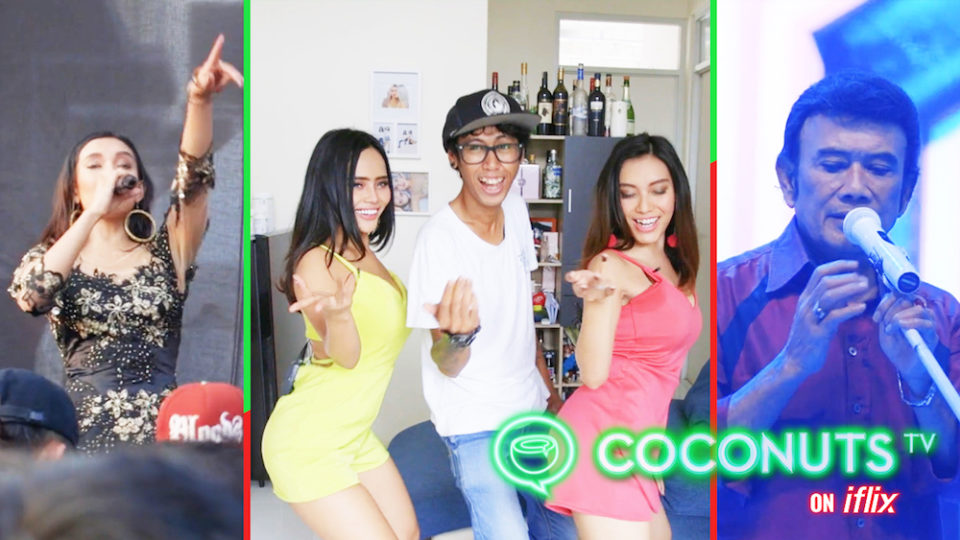PRESENTED BY
Our brand-new documentary series, COCONUTS TV ON IFLIX, the first original docu-series to drop on the streaming service, is out right now! While the six-episode series is available exclusively on iflix, you can get a taste of the series by watching a special segment from the first episode, “Dang, it’s Dangdut” right here. Read on to learn more about the sexy world of dangdut and how it became so dang popular in conservative Indonesia.
It’s hard to deny that Indonesia’s Muslim-majority population has become increasingly conservative in recent years. Once rare, women wearing the hijab (Islamic headscarf) has now become a common sight, the government expends huge amounts of resources to keep pornography off of the Indonesian internet and TV stations have been ordered to blur even the most modest of cleavage (even on cartoon characters).
But despite all that, there is one aspect of Indonesian popular culture that refuses to follow the country’s slide towards conservatism, and that is dangdut.
Dangdut is an onomatopoeia word that describes the distinctive sound of the tabla drum, which is an essential component of any dangdut beat. Created during 1960s, during the reign of the country’s founding father Sukarno (when western pop music like that of the Beatles was largely banned from the country), dangdut is a uniquely Indonesian music genre but draws extensively from Arabic, Malay and Indian (especially Bollywood) influences.
Dangdut is inextricably linked to Rhoma Irama, still regarded as “The King of Dangdut”, who first popularized the genre and filled many of his songs with explicitly moral messages (the legendary musician, who still performs regularly, is also an Islamic preacher). His songs were aimed at the rakyat (common people), as opposed to the country’s elites, and while he may have adopted the look of a rebellious western rock-and-roller, many of his songs are sermons against the evils of things like staying up all night, alcohol and drugs.
https://www.youtube.com/watch?v=w-_ZfvTfYvE
In many ways, dangdut was and is still regarded as a form of populist entertainment for the lower classes. But its popularity exploded during the 1980s and 1990s as it was promoted by the media as well as politicians who used dangdut as a way to reach the rakyat.
The genre’s real heyday came in 1990s, thanks largely due to the creation of dangdut koplo, a sub-genre that gained prominence at the end of the last millennium by incorporating more western musical influences, such as pop, rock and reggae, as well as a faster tempo based on the distinctive koplo rhythm of kendang drums.
But the real appeal of dangdut koplo lies not in it’s up-beat tempo but in the sexy and provocative singers that serenade the crowds over those throbbing koplo beats. While dangdut had always included elements of sensuality, dangdut koplo took it to a whole new level through the racy performances of singers such as Inul Vista, the sub-genre’s first true superstar.
While she’s now more associated with her wildly successful chain of family karaoke parlors spread across the country, for a time in the early 2000s Invul Vista was one of the most popular and polarizing figures in Indonesia. Her signature hip-shaking dance move, dubbed “goyang ngebor” (shaking drill), made her an almost instant celebrity throughout Indonesia as well as the target of criticism by the likes of Rhoma Irama and the Indonesian Ulema Council (MUI), who declared her eroticized dance moves “pornographic”. MUI tried to get her performances banned while Rhoma Irama denounced Inul’s dancing as “a threat to the country” and sexy dangdut koplo as being divorced from true dangdut.
“The king” may have denounced her, but Inul revolutionized the world of dangdut, showing that mainstream Indonesian audiences still had an appetite for risque rhythms. Her huge success inevitably led to new dangdut acts attempting to outdo her in terms of audaciousness, an erotic arms race that led to such provocations such as Dewi Persik’s “goyang gergaji” (“shaking saw”) and Duo Serigala’s “goyang dribble”.
https://youtu.be/HgUXlG-hOzg
But for every dangdut divas who managed to make it big with their audacious acts, there are countless others who perform at small events or dangdut clubs around the country, whose meager pay is supplemented by tips handed to them by lusty audience members who come to gyrate alongside them. Some resort to gimmicks such as snake dancing in order to stand out from the crowd, as was the case with Irma Bule, a dangdut singer and mother of three who died on stage in 2016 after being bitten by the snake she was performing with.
The death of Irma Bule, as well as legendary dangdut bombshell Julia Perez, who tragically passed away last year as a result of cervical cancer, may signal the end of the dangdut industry’s reliance on raw sexuality as its primary marketing tool. In recent years, singers such as Ayu Ting Ting and Via Vallens have managed to become super stars by projecting a more playful sense of schoolgirl cuteness than outright sexiness in their performances.
Whether this trend is due to Indonesia’s increasing cultural conservatism or simply changing tastes is debatable, since up-and-coming dangdut stars such as Duo Biduan still very much make smoldering sexuality a major part of their performance personas.
What is clear is that dangdut is very much here to stay in Indonesia, in one form of another. More than half-a-century since the genre was born, D’Academy, a dangdut singing competition, is the highest rated television show in the country. During each daily airing of its 3-month long seasons, millions of Indonesians tune in to watch dangdut dreamers hoping to become the next Rhoma Irama or Inul Vista.
https://www.youtube.com/watch?v=nvHzb0smg5Q









